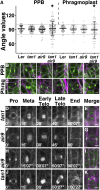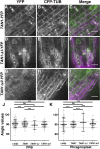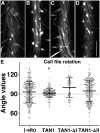Division Plane Orientation Defects Revealed by a Synthetic Double Mutant Phenotype
- PMID: 29146775
- PMCID: PMC5761783
- DOI: 10.1104/pp.17.01075
Division Plane Orientation Defects Revealed by a Synthetic Double Mutant Phenotype
Abstract
TANGLED1 (TAN1) and AUXIN-INDUCED-IN-ROOTS9 (AIR9) are microtubule-binding proteins that localize to the division site in plants. Their function in Arabidopsis (Arabidopsis thaliana) remained unclear because neither tan1 nor air9 single mutants have a strong phenotype. We show that tan1 air9 double mutants have a synthetic phenotype consisting of short, twisted roots with disordered cortical microtubule arrays that are hypersensitive to a microtubule-depolymerizing drug. The tan1 air9 double mutants have significant defects in division plane orientation due to failures in placing the new cell wall at the correct division site. Full-length TAN1 fused to yellow fluorescent protein, TAN1-YFP, and several deletion constructs were transformed into the double mutant to assess which regions of TAN1 are required for its function in root growth, root twisting, and division plane orientation. TAN1-YFP expressed in tan1 air9 significantly rescued the double mutant phenotype in all three respects. Interestingly, TAN1 missing the first 126 amino acids, TAN1-ΔI-YFP, failed to rescue the double mutant phenotype, while TAN1 missing a conserved middle region, TAN1-ΔII-YFP, significantly rescued the mutant phenotype in terms of root growth and division plane orientation but not root twisting. We use the tan1 air9 double mutant to discover new functions for TAN1 and AIR9 during phragmoplast guidance and root morphogenesis.
© 2018 American Society of Plant Biologists. All Rights Reserved.
Figures






Similar articles
-
Defects in division plane positioning in the root meristematic zone affect cell organization in the differentiation zone.J Cell Sci. 2022 Oct 1;135(19):jcs260127. doi: 10.1242/jcs.260127. Epub 2022 Sep 29. J Cell Sci. 2022. PMID: 36074053 Free PMC article.
-
The localization of PHRAGMOPLAST ORIENTING KINESIN1 at the division site depends on the microtubule-binding proteins TANGLED1 and AUXIN-INDUCED IN ROOT CULTURES9 in Arabidopsis.Plant Cell. 2022 Oct 27;34(11):4583-4599. doi: 10.1093/plcell/koac266. Plant Cell. 2022. PMID: 36005863 Free PMC article.
-
Involvement of YODA and mitogen activated protein kinase 6 in Arabidopsis post-embryogenic root development through auxin up-regulation and cell division plane orientation.New Phytol. 2014 Sep;203(4):1175-1193. doi: 10.1111/nph.12880. Epub 2014 Jun 13. New Phytol. 2014. PMID: 24923680 Free PMC article.
-
Proper division plane orientation and mitotic progression together allow normal growth of maize.Proc Natl Acad Sci U S A. 2017 Mar 7;114(10):2759-2764. doi: 10.1073/pnas.1619252114. Epub 2017 Feb 15. Proc Natl Acad Sci U S A. 2017. PMID: 28202734 Free PMC article.
-
An overview of plant division-plane orientation.New Phytol. 2018 Jul;219(2):505-512. doi: 10.1111/nph.15183. Epub 2018 Apr 27. New Phytol. 2018. PMID: 29701870 Review.
Cited by
-
Cell biology of primary cell wall synthesis in plants.Plant Cell. 2022 Jan 20;34(1):103-128. doi: 10.1093/plcell/koab249. Plant Cell. 2022. PMID: 34613413 Free PMC article. Review.
-
Predicting Division Planes of Three-Dimensional Cells by Soap-Film Minimization.Plant Cell. 2018 Oct;30(10):2255-2266. doi: 10.1105/tpc.18.00401. Epub 2018 Aug 27. Plant Cell. 2018. PMID: 30150312 Free PMC article.
-
Differentiation Disorders of Chara vulgaris Spermatids following Treatment with Propyzamide.Cells. 2023 Apr 27;12(9):1268. doi: 10.3390/cells12091268. Cells. 2023. PMID: 37174667 Free PMC article.
-
Defects in division plane positioning in the root meristematic zone affect cell organization in the differentiation zone.J Cell Sci. 2022 Oct 1;135(19):jcs260127. doi: 10.1242/jcs.260127. Epub 2022 Sep 29. J Cell Sci. 2022. PMID: 36074053 Free PMC article.
-
Molecular mechanisms of contractile-ring constriction and membrane trafficking in cytokinesis.Biophys Rev. 2018 Dec;10(6):1649-1666. doi: 10.1007/s12551-018-0479-3. Epub 2018 Nov 17. Biophys Rev. 2018. PMID: 30448943 Free PMC article. Review.
References
-
- Abrash EB, Bergmann DC (2009) Asymmetric cell divisions: a view from plant development. Dev Cell 16: 783–796 - PubMed
-
- Ambrose JC, Cyr R (2008) Mitotic spindle organization by the preprophase band. Mol Plant 1: 950–960 - PubMed
-
- Baskin TI. (2001) On the alignment of cellulose microfibrils by cortical microtubules: a review and a model. Protoplasma 215: 150–171 - PubMed
Publication types
MeSH terms
Substances
LinkOut - more resources
Full Text Sources
Other Literature Sources
Molecular Biology Databases

